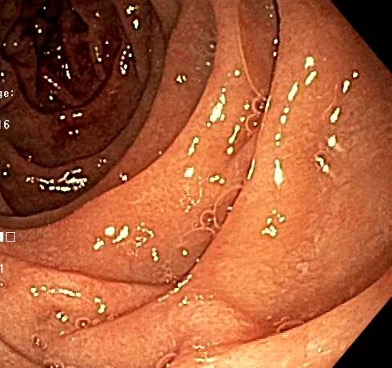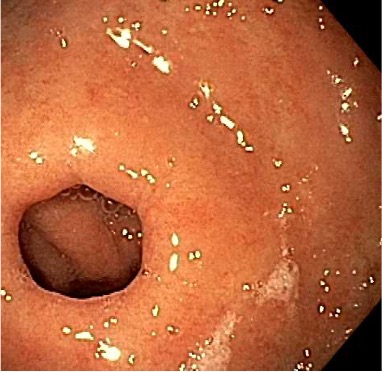Tuesday Poster Session
Category: Infections and Microbiome
P5614 - Strongyloidiasis Discovered on Duodenal Biopsy: Revisiting the Differential for Chronic Nausea and Weight Loss
Tuesday, October 28, 2025
10:30 AM - 4:00 PM PDT
Location: Exhibit Hall
- VD
Vishal Dobaria, MD (he/him/his)
University of Hawaii, John A. Burns School of Medicine, Department of Medicine
Honolulu, HI
Presenting Author(s)
Vishal Dobaria, MD1, Yusuke Miyatani, MD1, Arvin Jeremy N. Tan, MD1, Toru Nakata, MD, PhD1, Traci T. Murakami, MD, FACG2
1University of Hawaii, John A. Burns School of Medicine, Department of Medicine, Honolulu, HI; 2The Queen's Medical Center, Ewa Beach, HI
Introduction: Nearly one quarter of all pathological gastroenterology outpatient clinic visits are associated with unintentional weight loss and decreased appetite and thus the differential remains broad. Strongyloidiasis is a rarer cause of anorexia, often more prevalent in the immunosuppressed population. We report a unique instance of duodenal strongyloidiasis that was confirmatory on EGD biopsy.
Case Description/
Methods: An 86-year-old Hispanic male presented to the clinic with a several month-long history of decreased appetite, 16-pound weight loss, and occasional bilious vomiting. Patient’s surgical history was significant for diverticular bleed status-post sub-total right colectomy six years prior to presentation, which was complicated by recurrent small bowel obstruction requiring repeat partial colonic resection approximately one year prior to presentation. Patient had traveled to Mexico and Thailand over 30 years ago but had no recent travel history. Prior work-up with barium swallow study demonstrated slowness of contrast near the anastomotic area. Patient underwent EGD which demonstrated two sessile polyps within the stomach. Hematin and diffuse moderately erythematous mucosa was also seen within the stomach. Examination of the duodenum was normal on direct visualization. Cold forceps duodenal biopsies were obtained to rule out celiac’s disease. Pathology of the duodenal specimen yielded active duodenitis and helminths consistent with strongyloidiasis stercoralis. Patient was initiated on treatment with ivermectin after referral to infectious diseases specialist. The patient was then able to stabilize his weight and regained 12 pounds over the next 2 months.
Discussion: Strongyloides stercoralis is estimated to be diagnosed in 30 to 100 million people worldwide. However, typical cases of strongyloidiasis often involve an immunocompromised patients who present with nonspecific gastrointestinal symptoms including abdominal pain, diarrhea, nausea, vomiting, and weight loss. While stool and ova parasite sampling may help to identify the condition, this diagnostic measure may often be underutilized or ineffectively capture true positives. In this case, early diagnostic intervention with EGD and abrupt initiation of treatment may have helped to reduce the risk of helminth hyper infection syndrome and expedited the patient’s recovery.

Figure: EGD of normal duodenal mucosa. Biopsied.

Figure: EGD of stomach demonstrating mucosa and two gastric polyps. Biopsied.
Disclosures:
Vishal Dobaria indicated no relevant financial relationships.
Yusuke Miyatani indicated no relevant financial relationships.
Arvin Jeremy Tan indicated no relevant financial relationships.
Toru Nakata indicated no relevant financial relationships.
Traci Murakami indicated no relevant financial relationships.
Vishal Dobaria, MD1, Yusuke Miyatani, MD1, Arvin Jeremy N. Tan, MD1, Toru Nakata, MD, PhD1, Traci T. Murakami, MD, FACG2. P5614 - Strongyloidiasis Discovered on Duodenal Biopsy: Revisiting the Differential for Chronic Nausea and Weight Loss, ACG 2025 Annual Scientific Meeting Abstracts. Phoenix, AZ: American College of Gastroenterology.
1University of Hawaii, John A. Burns School of Medicine, Department of Medicine, Honolulu, HI; 2The Queen's Medical Center, Ewa Beach, HI
Introduction: Nearly one quarter of all pathological gastroenterology outpatient clinic visits are associated with unintentional weight loss and decreased appetite and thus the differential remains broad. Strongyloidiasis is a rarer cause of anorexia, often more prevalent in the immunosuppressed population. We report a unique instance of duodenal strongyloidiasis that was confirmatory on EGD biopsy.
Case Description/
Methods: An 86-year-old Hispanic male presented to the clinic with a several month-long history of decreased appetite, 16-pound weight loss, and occasional bilious vomiting. Patient’s surgical history was significant for diverticular bleed status-post sub-total right colectomy six years prior to presentation, which was complicated by recurrent small bowel obstruction requiring repeat partial colonic resection approximately one year prior to presentation. Patient had traveled to Mexico and Thailand over 30 years ago but had no recent travel history. Prior work-up with barium swallow study demonstrated slowness of contrast near the anastomotic area. Patient underwent EGD which demonstrated two sessile polyps within the stomach. Hematin and diffuse moderately erythematous mucosa was also seen within the stomach. Examination of the duodenum was normal on direct visualization. Cold forceps duodenal biopsies were obtained to rule out celiac’s disease. Pathology of the duodenal specimen yielded active duodenitis and helminths consistent with strongyloidiasis stercoralis. Patient was initiated on treatment with ivermectin after referral to infectious diseases specialist. The patient was then able to stabilize his weight and regained 12 pounds over the next 2 months.
Discussion: Strongyloides stercoralis is estimated to be diagnosed in 30 to 100 million people worldwide. However, typical cases of strongyloidiasis often involve an immunocompromised patients who present with nonspecific gastrointestinal symptoms including abdominal pain, diarrhea, nausea, vomiting, and weight loss. While stool and ova parasite sampling may help to identify the condition, this diagnostic measure may often be underutilized or ineffectively capture true positives. In this case, early diagnostic intervention with EGD and abrupt initiation of treatment may have helped to reduce the risk of helminth hyper infection syndrome and expedited the patient’s recovery.

Figure: EGD of normal duodenal mucosa. Biopsied.

Figure: EGD of stomach demonstrating mucosa and two gastric polyps. Biopsied.
Disclosures:
Vishal Dobaria indicated no relevant financial relationships.
Yusuke Miyatani indicated no relevant financial relationships.
Arvin Jeremy Tan indicated no relevant financial relationships.
Toru Nakata indicated no relevant financial relationships.
Traci Murakami indicated no relevant financial relationships.
Vishal Dobaria, MD1, Yusuke Miyatani, MD1, Arvin Jeremy N. Tan, MD1, Toru Nakata, MD, PhD1, Traci T. Murakami, MD, FACG2. P5614 - Strongyloidiasis Discovered on Duodenal Biopsy: Revisiting the Differential for Chronic Nausea and Weight Loss, ACG 2025 Annual Scientific Meeting Abstracts. Phoenix, AZ: American College of Gastroenterology.
